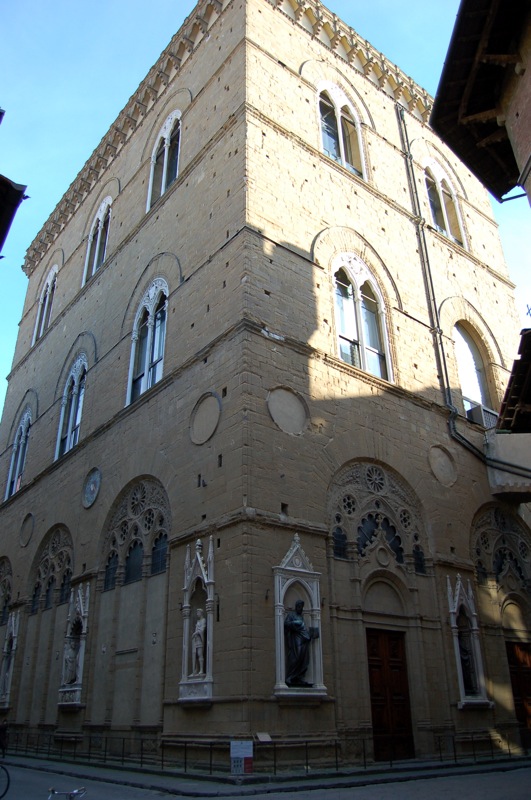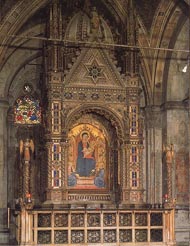

Since the later thirteenth century, the city grain market had been located on this site. Grain supply was crucial to the stability of urban life. Consequently towns intervened to take steps to control supplies and prices. The current building was begun in 1336 and replaced an older wooden loggia that had been destroyed by fire. Orsanmichele was originally an open loggia around the central grain market of Florence. Located at the heart of Florence along an axis extending from the cathedral to the townhall, Orsanmichele represents the intersection of econmic, civic and religious life. After the completion of the ground floor in the 1350s and the upper stories were begun, it was decided to enclose the open loggia. Inside was a tabernacle which protected a miracle working image of the Madonna and Child. After the outbreak of the plague in 1348, an upper story was added to house a granary to guard against famine. Between 1355-59, Andrea di Cione, or Orcagna, replaced the original tabernacle that now housed a painting of the Madonna and Child by Bernardo Daddi (active c. 1320-48), which had replaced the earlier miracle working image:

In the Trecento each guild had been assigned the task of filling one of the niches on the exterior of a building with a freestanding statue of its patron saint. By the early fifteenth-century only three of the fourteen guilds had completed their niches. In 1406 the Signoria or governors of Florence, impatient to complete the project, declared that the guilds must fill their niches within a ten year period.
Aldo Galli in The Springtime of the Renaissance (2013), p. 89: In the eyes of his contemporaries, the most obvious new element in Donatello's figures must have been their individual characterization. This was both a psychological and physical characterization that made those prophets and saints far more memorable than those that had been sculpted in the city until then. The statues of the large public construction sties of the 14th century express the desire to stand out as a series rather than as individual units. This is especially evident in the cycle of the Prophets and Sibyls made for the Campanile of the cathedral by Andrea Pisano and his collaborators, in which the search for uniformity among the various figures is far more pronounced than any individual features...."

For the complete set of statues see Wikipedia entry for Orsamichele
See also the Orsanmichele Church and Museum web site.
See Wikipedia for the Guilds of Florence.
|
|
Guild |
|
|
|
East Side |
1 Arte del Giudici e Notai (magistrates guild) |
|
|
| 2 Tribunale di Mercanzia (merchants' court) | Verrocchio, Doubting Thomas, bronze, c. 1463-80. Replaced Donatello's St Louis of Toulouse for the Parte Guelfa, c. 1423-5. | ||
| 3 Arte di Calimala (wool merchant's guild) |
|
|
|
|
South Side |
4 Arte della Seta (silk merchant's guild) |
|
|
| 5 Arte del Medici e Speziali (doctors' and apothecaries' guild) |
|
||
| 6 Arte del Conciatori e Pellicciai (furriers' guild) |
|
||
| 7 Arte del Linaivoli e Rigattieri (linen-weavers' and peddlars' guild) |
|
|
|
|
West Side |
8 Arte del Maneschalchi (blacksmith's guild) |
|
|
| 9 Arte della Lana (wool manufacturers' guild) |
Ghiberti, St. Stephen, bronze, 1428.
|
|
|
| 10 Arte del Cambiatori e Banchieri (guild of the Money Changers and Lenders) |
|
|
|
| 11 Arte del Corazzai e Spadai (armourers' guild) |
|
|
|
| 12 Arte del Maestri di Pietra e di Legname (wood and stone workers' guild) |
|
|
|
| 13 Arte del Calzaiuoli (shoemakers' guild) |
|
||
| 14 Arte del Beccai (butchers' guild) |
|
||
| For complete set of illustrations see Orsanmichele Church and Museum that is part of the Museums of Florence website. | |||
Observe that the richest guilds --the Calimala (importers and exporters of cloth), the Cambio (bankers), and the Lana (wool manufacturers)-- decided to make their figures in bronze, which cost approximately ten times the amount of the stone figures.
Richard Turner (Renaissance Florence, p. 51) presents the following assessment of the works that emerged from this campaign:
Between 1410 and 1425 a wholly new public sculpture arose in Florence, whose premisses are a compelling physical and pyschological presences, figures intended to be "in dialogue" with the people in the streets below. These sculptures seem to possess a larger than life heroism, breaking out from the niche-constricted passivity of sculpture on Gothic cathedral facades, from which they evolved. This radically new sculpture pre-dates any comparable innovations in architecture and painting, and unequivocally constitutes the point of departure for a new art in Florence.
Assignment: Considering such praise, it is crucial that we make our own assessment of these works. We will focus on five of these projects:
In 1418 Donatello was commissioned to make the so-called Marzocco, a heraldic lion symbolic of Florence. Donatello's lion was placed in front of the Palazzo Vecchio in the nineteenth century. The Marzocco replaced an earlier lion, whose importance as a civic monument is demonstrated by its appearance by the front wall of the Palazzo Vecchio in Ghirlandaio's fresco of Pope Honorius III Sanctioning the Franciscan Order in the Sassetti Chapel:
The comparison of the face and bearing of the Marzocco to Donatello's St. George is striking.
We need to address special attention to the so-called predella beneath Donatello's St. George:

This flattened relief (rilievo schiacciato), representing the story of St. George and the Dragon, was a revolutionary innovation on the part of Donatello, and anticipates many of the pictorial innovations of Florentine painting of the third decade of the fifteenth-century.
Compare Donatello's handling of relief sculpture to that found in Nanni di Banco's predella for the Quattro Coronati:
Look at these works carefully, and come up with your own assessment of the merits of these works.
Scholars have seen a close association between the sculptural innovations of these works and the development of a new ideology known as civic humanism. Read the excerpts from Leonardo Bruni's writings in relationship to these works.
See Orsanmichele Church and Museum that is part of the Museums of Florence website.